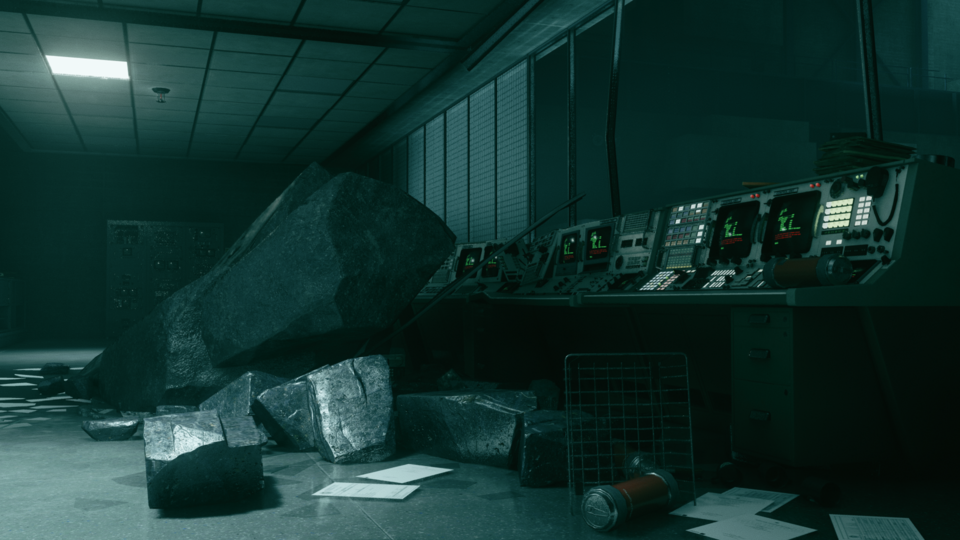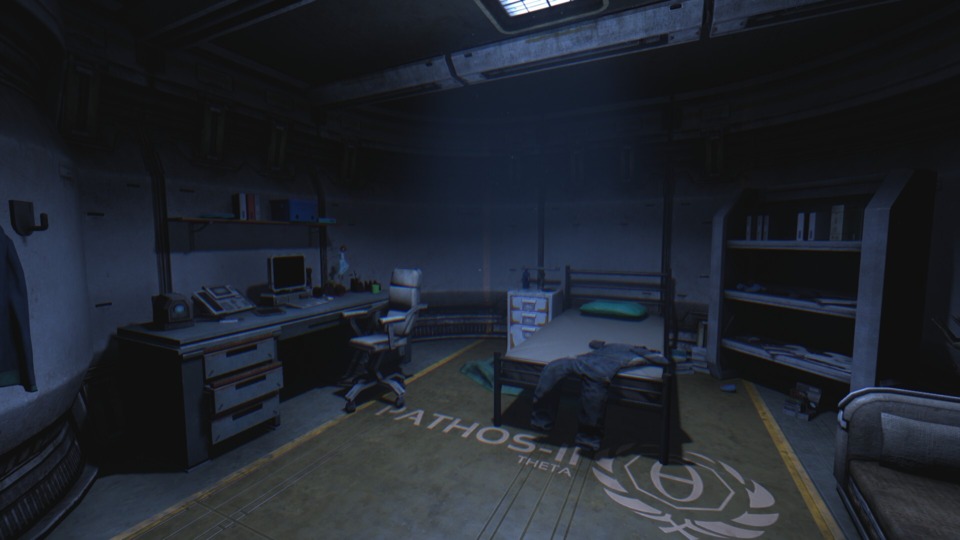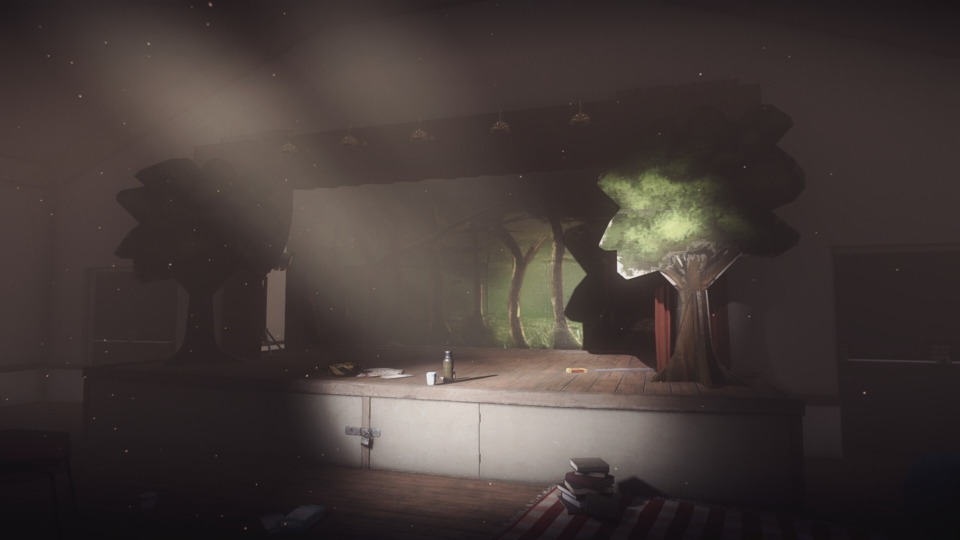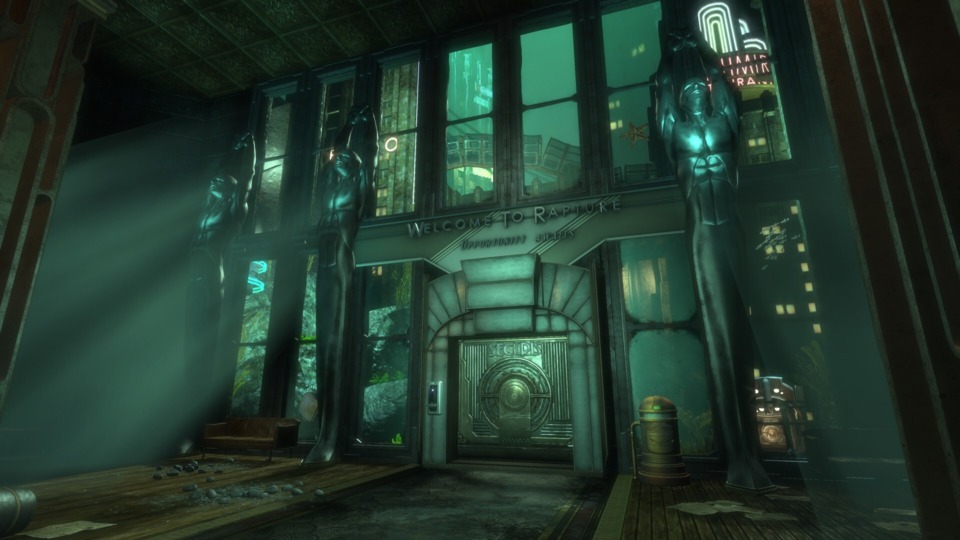Haunted: The Influence of Environmental Storytelling
By gamer_152 0 Comments
Note: The following article contains significant spoilers for Bioshock, Virginia, and Paratopic.

The games community has had ahold of the phrase "environmental storytelling" for a good decade and a half. It was thrust into our lexicon in the late 00s and early 10s with launch pads like Bioshock and Gone Home: thrillers that immaculately married place and history. "Environmental storytelling" is often a misnomer, as readily used to describe a location characterising something or someone as performing exposition. It also wasn't a new idea, even in 2007. If you visit the palace in the JRPG once and it's pristine, then you return, and its windows are broken and valuables pilfered, that's environmental storytelling. If you approach a cave and there's a "Danger" sign on the path to it and a skeleton hanging out of the cave mouth, that's environmental storytelling. All the way back to the ancient text adventures of the 1970s, games used their worlds to scratch out the runes of narratives.
What was special about the era of Gone Home was that audiences and developers found locational text could carry a depth none of us had seen before. There became an invigorated interest in chiselling out the personalities of virtual worlds and characters with props, architecture, and interior design rather than writing. And it worked, up to a point. Bioshock and Gone Home's environments elevated their games' storytelling capabilities, and in projects since, including Control, Prey (2017), Paratopic, Little Nightmares, Off-Peak, What Remains of Edith Finch, and innumerable others, environments have narrated to flooring effect.
But we placed too much weight on environmental storytelling's shoulders. An entrenched problem for video games has been finding room to tell tales. Many fall into this layer cake format where you get a lot of play conducted in some environment, and then a little narrative is told through cutscenes, audio, or screens of text outside that environment. That's followed by a lot more gameplay, and you go back and forth between the two. At the time environmental storytelling was in the limelight, this structuring was especially prevalent.
So many games were struggling to pack in the exposition and dialogue that a compelling story needs. But if we're spending most of our time in gameplay arenas and those arenas tell the story, problem solved. Environmental storytelling would seem to prevent or at least limit the slicing of games into narrative and gameplay slabs that never fully integrate. It could make exposition and characterisation constant rather than pulsing it on and off. As a bonus, environmental storytelling cuts down on costly animation and voice acting.

Every major art form found a way to convey the ideas it wanted to in accordance with its unique faculties. Cinematography is a language that leverages the motion picture nature of films to make implications about characters, locations, objects, and events. Music theory allows composers to do something similar using pitch and rhythm. And video games have long sought an accepted and cohesive body of theory and techniques for doing the same. Computer games generally involve moving through spaces, so maybe the spaces were the conceptual carrier wave unique to the medium. Maybe environmental storytelling could be our cinematography.
But there were obstacles to having a game's staging narrate a sizeable portion of its story. There was no indicator that environmental vocabulary had all the words in it that you'd need to establish a language. English, Spanish, and cinematography were designed for expedient communication on any topic, but the way we leave clothes on the floor or decorate our rumpus room weren't optimised for the same. When writing with environmental storytelling, we have the vocabulary to say, "This train carriage was abandoned in a hurry", or "This homeowner is neat and meticulous", or "There were surgeries performed here", but how do you say "Alice slapped Bob", or "This grave was raided by pirates" or "Miguel is set to inherit his father's fortune when he dies"? How would you write Hamlet, Salem's Lot, or an episode of Frasier with an environment?
If you're anything like me, the first place your mind goes in trying to answer those questions is to written text. You place Miguel's father's will on a table or have Bob write a letter about Alice, and there's nothing wrong with that approach. Still, it's not environmental storytelling as we typically look for it. One of the reasons that we sought out communication through setting was to minimise the quantity of written text in a game; to get away from scenarios in which the player is turning away from active engagement with their surroundings towards a wall of monologuing or dialoguing.
Games have increasingly tried to reconcile the advantages of the text log and the environment by having characters graffiti their thoughts on walls, but it's not very elegant. It is firmly on the "tell" end of the "show don't tell" spectrum. Sometimes, inelegant is what you want. Many video game settings aim to scream danger, and blood smeared on a surface does that. But it's far from an all-purpose communication channel. We've all encountered pronouncements writ large on a video game wall and thought they were hokey or stretched the bounds of believability. Is your character really going to choose this as their notepad if they have other choices? What's more, to be a replacement for other forms of dialogue and plotting, a character would need to graffiti the same messages as the author would write. Are they likely to do that? And how much prose can you fit on the walls? Enough to tell the whole plot with asides for fleshing out all your characters? Wall text is a small speaker in a big concert hall. And gain, it's writing.

It's also worthy of note that many locational clues for plot events or character quirks fly under plenty of players' radars when not reinforced by traditional storytelling craft. This is apparent in Virginia and Paratopic, among other games. Paratopic has little dialogue, and Virginia has none. Forgoing the clarifications of written and verbal language, these games become enigmatic. Without explicit fail states, we could read them as non-challenging, but the challenge is there: it's in working out even the rough guidelines of the narrative. It's decoding the origin of the hospital bed in Ortega's house or the emaciated face on the bunker's TV screens. Virginia and Paratopic are brilliant in their encryption, and most audiences like a mystery, but not one so encompassing it shrouds the basic premise of the story. That's a niche.
Let's return to those examples of story beats from earlier: a train car being hurriedly evacuated versus Alice slapping Bob, a place being used as a surgery versus a grave being plundered by pirates. The difference between those narrative quanta we can voice through environmental storytelling and those we cannot is that the latter deposit no physical evidence outside of maybe documentation. A hasty exit from a train car might leave jackets and luggage and half-eaten plates of food. Surgery requires medical equipment and a lot of it. But an argument or being a pirate while graverobbing? There's no paraphernalia that uniquely identifies those actions or materials those behaviours produce. Without an object, building, or mark left on the environment, there is no substrate there for storytelling through setting.
To reword, some things you can tell about people and their world even when those people are absent from the scene. But there are other details that require the presence of those characters, in speech or conventional text, if not in the flesh. A gesture, words spoken aloud, a posture, a touch between two people: these are all something either someone makes a record of or you have to be in the room to witness. It's a reason why some games place ghosts or holograms in your vicinity. Even when studios can't spring for a fully-animated character, or it would suffocate their desired aesthetic, there are certain things they need bodies there to communicate.
For a few surreal wonders, this is where interpretive environments come into play: metaphysical dimensions wallpapered with the psyches of their dreamers. For example, the frazzled minds in Psychonauts, the ocean of depression in Sea of Solitude, or the Rorschach town of Silent Hill. It's a potentially sublime way to paint a setting, but it is not for every game. In the pirate example, we could imagine that maybe the thieves drop some gold coins in their frenzy, but that's only appropriate for a fairly cartoony experience. Sometimes an investigator identifies events or people from inconspicuous evidence like the tracks in a bootprint or the hair on a jacket, but that's going to be unsuitable outside of a certain genre. That solution also assumes something about the player's observation skills and the camera at their disposal.

Most of the time we interpret such clues in an investigation game, it's with the help of written or spoken language. In general, whether a player is going to notice environmental features depends on the nature of the play because you're going to place your attention where the design motivates you to, some UIs allow more overlays and unrealistic elements than others, and play affects how the camera can move. For example, if you are fighting enemies or in a fast-moving vehicle, you're not likely to perceive granular details in your surroundings.
And when we have to read peoples' actions from evidence in the environment alone, a game can only speak to character actions in the past (e.g. They dropped a bag of marbles on the floor or bought a new pet) or which are ongoing (e.g. They're building a treehouse or attending weekly church services). So, environments, by themselves, can't narrate actions in the present unless they're caused by someone in another room, like a person setting off an alarm in the chamber you're in. Technically, characters create a narrative in the present as they interact with a location. "I placed a blender on the kitchen counter" or "This soldier busted down a door" are bullet points in narratives. But I don't think this is what people mean when they say "environmental storytelling". The term is invariably used to describe storytelling by an environment alone, not a character storytelling through their interactions with the environment.
And if you're communicating primarily through the setting, you're pushing people, in their tangible form, into the background. A level in which no one is present but character actions and natures bleed from the walls often has a despondent, haunted feel. The same is true if your story is told in echoes and is far more past than present, which, as discussed, an environmentally-related story is going to be. Like a spirit, the plot lingers in the location, but you can't touch it.
By placing player characters somewhere alone, developers also tend to make statements about the player's viewpoint, the place they find themselves in, or both. Either the audience is somewhere where they can't get regular humanising contact with other people, or they're somewhere they can but are choosing to sneak around others. The player could even be dwelling in a location people generally wouldn't inhabit, like a cave or ocean trench, or an anthropocentric zone, but one empty of people. That could be a stranger's bedroom while they're out, but on a large enough scale, you have abandoned buildings, and on a larger scale than that, abandoned cities.

It's worth thinking about how many of the stars of environmental storytelling are set in uncanny spaces possessed by a colourful history. And how many of them live in places without humans, with a story thinking retrospectively. There is Tacoma with its vacant space dormitories, the civilisational remnants in Nier, the ancient aquatic ruins of ABZÛ, or the village in Everybody's Gone to the Rapture. Because environmental storytelling relies on the rifling of history, the teeth marks of past events, games keen on the method are frequently about a past that won't wash off a place: The ruins of the post-apocalypse, the ship left adrift by its crew, unfulfilled desires in the mental landscape, etc.
Then, for every Virginia or Tacoma, there's been a game that's complacent and uninspired in its environmental storytelling. There are the ubiquitous walls scrawled with menacing messages, and then there are the infinite corpses in their infinite poses, suggesting all manner of grisly murders. Not that writing on any surface can't be pithy or that there aren't artistic uses for corpses. However, we keep seeing games use environmental storytelling to tell the same story over and over: that "People died here", usually by predictable circumstances and without meaningful plotting around it. As indie developer Ben Esposito joked, ""Environmental storytelling" is the art of placing skulls near a toilet".
This is one of those points that is obvious once you spell it out, but if you're using your environment to actualise tone, theme, character, or narrative, then the tone, theme, etc., you end up with is a product of your game's setting. I think that video games keep going back to the same wells for their setpieces, firstly, because environmental storytelling is not that mature a language. At least, not yet. But secondly, because if your worlds are recycled from exhausted nerd culture symbolism or are largely thin justifications for action combat, then the environmental storytelling doesn't have a lot to work with.
The environmental storytelling in Unpacking, Gone Home, Little Nightmares, and every other game we've discussed that stuns at this craft tells a humanising story or radiates humanising detail because it's set in a humanising environment. It takes place somewhere people can live a life, and therefore, leave evidence of personhood. Even Bioshock's Rapture, which exists in a state of perpetual downfall, cursed to be frozen on the night of a failed revolution, is somewhere people lived and not just spawned in. Its buildings' art deco facades tell you its architects aspired towards an affluent mid-century utopianism, its leaky and creaking bulkheads are an artefact of the city's poor infrastructural maintenance even before the collapse. You might see corpses strung up in Fort Frolic, but they're immortalised in a collage, the residue of the abnegation of ethics in Rapture in favour of absolute creative freedom.

It's not a weakness to have violence in your world, but whatever storytelling method you choose, it's going to have all the depth of a paddling pool if that violence is not couched within a human and emotional context. People play games. Take the personhood out of the world, even if it's an oppressed personhood, and you probably take out what's interesting about it. The games that fall hardest when taking a punt at environmental storytelling tend to be those that strip the cultural and personal from their worlds to adapt them purely to mechanistic gameplay. Because of the symbiotic relationship between environmental storytelling and a game's broader sensibilities, locational storytelling cannot be a crutch for a game that doesn't otherwise have promising narrative prospects. Instead, the environmental storytelling must receive support through thoughtful development of the world, its characters, and its iconography that considers all of these aspects beyond their capacity for empowerment antics.
Gone Home and Bioshock also could not have laminated themselves as storytelling classics in the medium if they weren't aware of where environmental storytelling is in its element and where it's not. While these games may be remembered for characterisation through setting, they each use some melange of text logs, audio recordings, internal monologue, and even face-to-face interactions, alongside their locational communication. They use environments when they're trying to paint a background or impart eeriness but trot out their characters when they need someone supportive or confrontational. They're aware there's a lot you can only learn from how someone builds a city or decorates a room, but also aware that there are intentions you can only hear in their voice or interactions that require meeting with them.
Rather than a school or style of video game storytelling, environmental storytelling and characterisation are tools available to the creator. From the current evidence, it would seem that they don't have the universal applicability of cinematography or music theory, and are far from a panacea for video games' storytelling woes. Instead, a strong narrative or world has to emerge from more foundational development work. It is when intense care is taken with the narrative and character of a game and when environmental storytelling is understood as an often absent, past-tense mode of speech that the tool comes into its own. Thanks for reading.